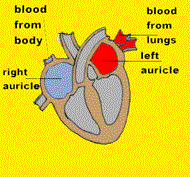|
Breathing is part of the respiratory system and is something you do all the time without thinking about it. You breathe so your body can get the oxygen it needs. |
|
|
|
|
|
|
|
|
|
|
|
|
|
|
|
|
|
|
|
|
|
|
Breathing is part of the respiratory system and is something you do all the time without thinking about it. You breathe so your body can get the oxygen it needs. |
|
|
When you breathe in, you suck in air. The air passes through your nose and throat. As you breathe in, your chest expands by raising your ribs. As your ribs rise up, your diaphragm drops down. Hairs in your nose filter out dust and bacteria carried in the air. The air is also warmed and moistened in your nose. This moistened warm air then passes down your windpipe or trachea, into two tubes called the bronchi. The bronchi divide into small branches that end in a mass of air sacs in your lungs. These air sacs are lined with tiny blood vessels called capillaries. Oxygen in the air seeps through the walls of the lungs and into the capillaries.. The capillaries carry the blood full of oxygen to larger veins. Sugar is also carried in the blood and this combines with the oxygen to make the energy you need to grow, work and play. |
 |
|
Large
veins carry the blood to your heart. Your heart then pumps it
all around your body. This is called the circulatory system. Your blood now contains large amounts of carbon dioxide. Carbon dioxide seeps from the capillaries into the lungs and is excreted when you breathe out. |
 |
|
|
AIR PLUS OXYGEN |
|
|